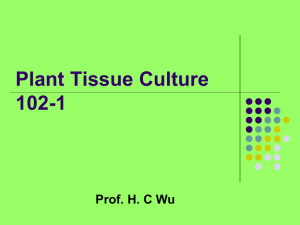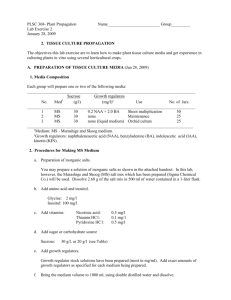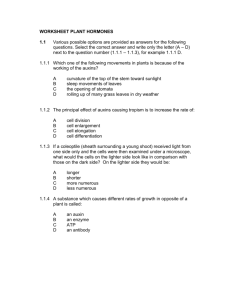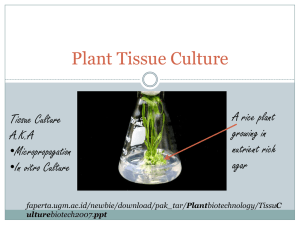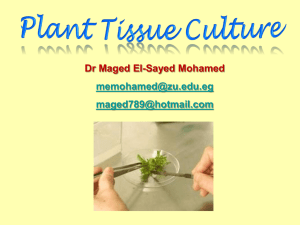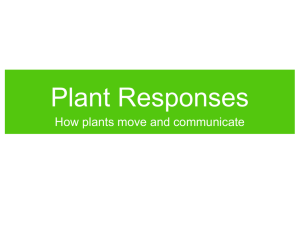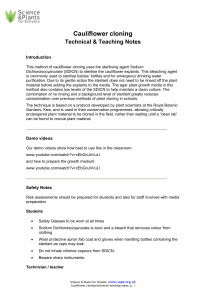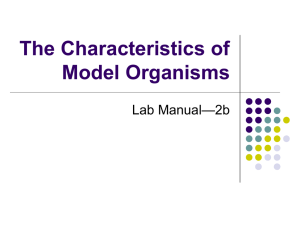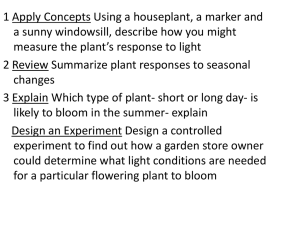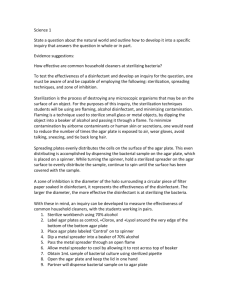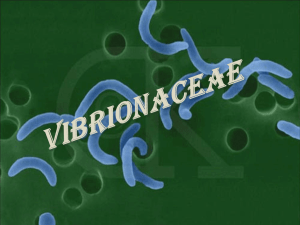Plant Tissue Culture Paper IV Unit III T.Y.B.Sc. Biotechnology
advertisement
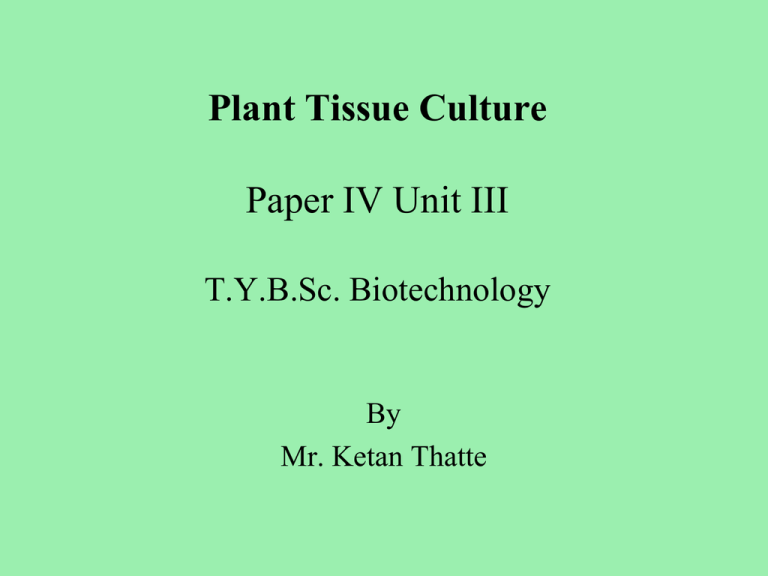
Plant Tissue Culture Paper IV Unit III T.Y.B.Sc. Biotechnology By Mr. Ketan Thatte Introduction What is Plant Tissue Culture? • Plant tissue culture is the aseptic (free from microorganism) culture of any plant part in vitro on an artificially prepared nutrient media and under controlled conditions. • Plant tissue culture relies on the fact that any plant cells have the ability to regenerate into a whole plant i.e. Totipotency. • Single cells, Protoplasts (plant cells without cell walls), Leaf material, nodal /internodal segments of stem or roots can often be used to generate a new plant on culture media. • It has advanced the knowledge of fundamental botany, especially in the field of agriculture, horticulture, plant breeding, forestry, somatic cell hybridization, phytopathology and industrial production of plant metabolites. Terminology in PTC • Auxin---A group of plant growth regulators that promotes callus growth, cell division, cell enlargement, adventitious buds, and lateral rooting. E.g. 2,4-Dichlorophenoxy acetic acid (2,4-D), Indole3-butyric acid (IBA), α-Naphthalene acetic acid (NAA) • Cytokinin---A group of plant growth regulators that regulate growth and morphogenesis stimulate cell division. Zeatin, 6-furfurylaminopurine (kinetin) and 6-benzylaminopurine (BA or BAP). • Gibberellins---A plant growth regulator that influences cell enlargement. Gibberellic Acid (GA3). • • • • • Explant---Tissue taken from its original site and transferred to an artificial medium for growth maintenance. Callus---An unorganized, proliferate mass of differentiated plant cells, a wound response. Totipotency---A cell characteristic in which the potential for forming all the cell types in the organism are retained. Micropropagation---In vitro clonal propagation of plants from shoot tips or nodal explants, usually with an accelerated proliferation of shoots during subcultures. Clonal Propagation---Asexual reproduction of plants that are considered to be genetically uniform and originated from a single individual or explant. • • • • Shoot Apical Meristem---Undifferentiated tissue, located within the shoot tip, generally appearing as a shiny dome-like structure, distal to the youngest leaf primordium and measuring less that 0.1 mm in length when excised. Somaclonal Variation---Phenotypic variation, either genetic or epigenetic in origin, displayed among somaclones. Somaclones---Plants derived from any form of cell culture involving the use of somatic plant cells. Or plants produced asexually from a single source plant. Subculture---This is the process by which the tissue or explant is first subdivide, then transferred into fresh culture medium. History • 1902: Haberlandt demonstrated the ‘Totipotency’. • 1902: Haberlandt reported single palisade cell culture from leaves in knop’s salt solution • 1904: Hanning practiced ‘Embryo culture’ of Crucifers. • 1925: Laibach recovered ‘Hybrid progeny from interspecific cross in Linum. • 1926-34: Discovery of IAA and role of Vit. B in plant growth and root development. • 1939: Gautheret, white and Nobecourt established first callus culture from cambium tissue. • 1944: Skoog reported ‘shoot bud differentiation’ in tobacco pith tissues. • 1955: Miller et al. discovered ‘kinetin’ enabled callus culture from differentiated tissues. • 1957: Skoog and Miller proposed ‘root-shoot differentiation’ in vitro by auxin-cytokinin ratio. • 1959: Braun regenerated first plant from mature plant cell. • 1958-59: Reinert and Stewart developed ‘somatic embryos’ from carrot. • 1960: Cocking isolated ‘Plant protoplast’ using cell wall digesting enzymes. Followed by Bergmann for ‘Suspension culture’. • 1962: Murashige and Skoog developed first complete nutrient medium. • 1964: Maheshwari and Guha produced ‘Haploid plants from pollen grains of Datura. • 1966: Nitch and Nitch isolated microspores of Tobacco to produce haploid plants via ‘Anther culture’. • 1972: Carlson et al. produced first somatic hybrid by fusing protoplasts of Nicotiana glauca and N. langsdorfii. • 1988: Levin et al. Developed bioreactor system for embryogenic and organogenic cultures of several plants. • 1990: Application of PTC techniques for the production of secondary metabolites from Medicinal and Aromatic plants. Culture Medium for Plant Tissue Culture • An artificially prepared liquid or gelatinous substance containing nutrients in which excised plant tissues or organs are cultivated is called as Culture Medium. • Chemically Defined: Composition and concentration of each nutrient is exactly known. • Chemically Undefined: Composition and concentration of nutrient is not exactly known due to addition of organic supplements. • Macro Inorganic Salts: It contains the salts that are needed in higher amounts. These include Nitrogen, Phosphorus, Sulphur, Magnesium, Calcium and Potassium. • Micro Inorganic Salts: It contains the salts that are needed in trace amounts. These include Boron, Manganese, Zinc, Iodine, Molybdenum, Copper and Cobalt. • Iron Source: It is supplied as a combination of Ferric salt and Disodium salt of Ethylene diamine tetra acetic acid (Fe-EDTA). • Amino Acids: Most commonly used amino acid is Glycine. • Vitamins: This includes Meso inositol, Nicotinic acid, Pyridoxine HCL, Thiamine HCL. • Carbon Source: Carbohydrates is supplied in the form of Sucrose. • Phytohormones: Generally Auxins and Cytokinins are required singly or in combination to initiate and maintain cells. • Auxins: IAA, IBA, NAA, 2,4-D. • Cytokinins: BAP, Kinetin, Zeatin, 2iPA, TDZ. • Agar: The culture medium is solidified with 0.8% agar. A semisolid medium is the one in which agar concentration is less than 0.8%. A medium devoid of agar is called liquid medium. Preparation of Stock Solution: • Macro salts: Stock is prepared as 20X. • Micro salts: Stock is prepared as 100X. • Iron EDTA: Stock is prepared as 50X • Vitamins & Growth Hormones: 1mg/ml. concentration. • Amino acids: 1mg/ml. • Sucrose and Agar agar is added as per the requirement. • Preparation of 1 Liter of MS Medium: Addition of stock solutions is done as follows: R x T/G where R is required concentration, G is given concentration, T is total volume Plant Nutrition VITAMINES • They function as catalyst in enzyme reaction • Thiamine required for carbohydrate metabolism and synthesis of amino acid • Other examples: Nicotinic acid, Pyridoxine HCl, Biotin, Folic acid, Riboflavin, pantothenic acid, Paraamino benzoic acid, Ascorbic acid. MYO-INOSITOL • It is a sugar alcohol, improves in-vitro responses AMINO ACIDS • Functions in purine synthesis and is a part of porphyrin ring of chlorophyll . CARBOHYDRATES • Sugars added in the medium act as an energy and carbon source • Act as osmoticum. Osmotic potential have an important effect on in-vitro response PLANT GROWTH REGULATORS • Auxins: It induces cell elongation, cell division and somatic embryogenesis. At higher concentration, auxin promotes root formation. • Cytokinins: Essential to promote cell division, lateral bud development and cytokinesis. At higher Concentration, they promote shoot formation. • Gibberellins: Influences stem elongation and flowering. Helps in seed germination by breaking the dormancy Element Role Nitrogen (N) Helps plant to synthesize complex organic molecules Important role in osmoregulation and anion-cation balance of plant. Phosphorous (P) Essential element in photosynthesis and respiration Affects plant maturation and root growth Potassium (K) Essential for normal cell division and promotes meristematic growth Involved in maintaining the turgor pressure of its cells In opening and closing of stomata Accumulation and translocation of carbohydrates Sulphur (S) Present in Cysteine and Methionine which are precursor for vitamins and coenzymes Calcium (Ca) Ca- pectate- an integral component of cell wall Element Roles Manganese (Mn) In Nitrate assimilation Involved in oxidation-reduction process in photosynthetic electron transport Boron (B) Helps in absorption of calcium and assists in pectin formation of cell wall Involved in cell division, differentiation, maturation, respiration Associated in pollen germination Molybdenum (Mo) Its deficiency results in deformation of flowers and leaves dieback Zinc (Zn) Activates auxin production Helps in chlorophyll formation and prevents chlorophyll destruction Copper (Cu) Involved in carbohydrate metabolism, nitrogen fixation and in oxygen reduction Cobalt (Co) Essential for Nitrogen fixing bacteria Component of Vit. B12 and enzymes, needed to form aromatic compounds Iron (Fe) Essential for chlorophyll formation
